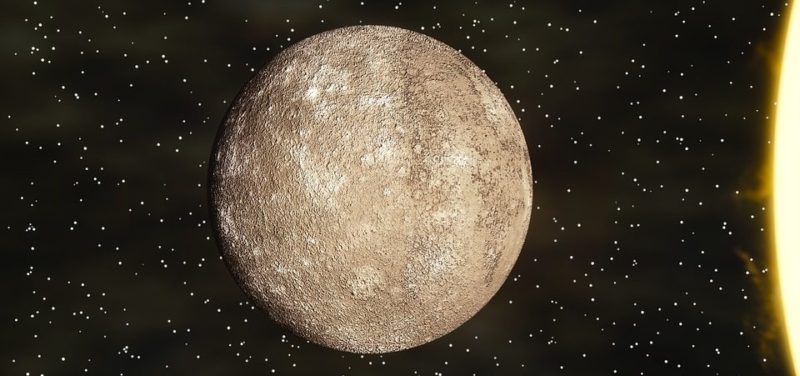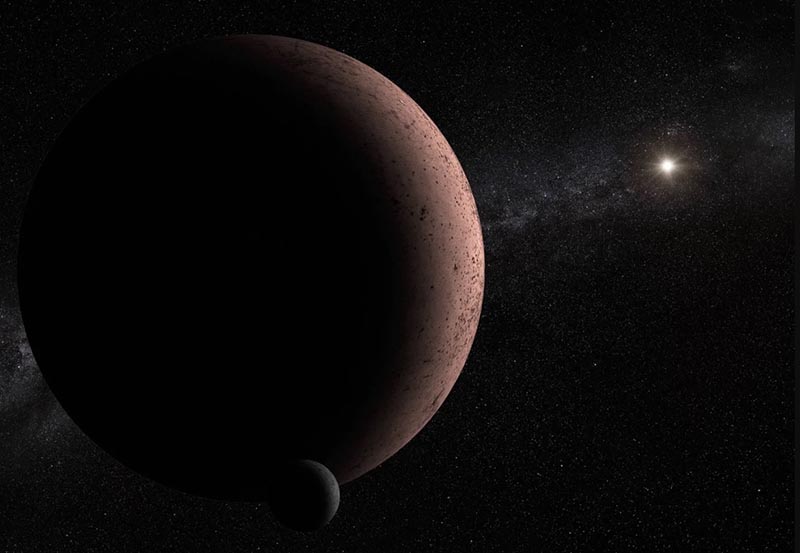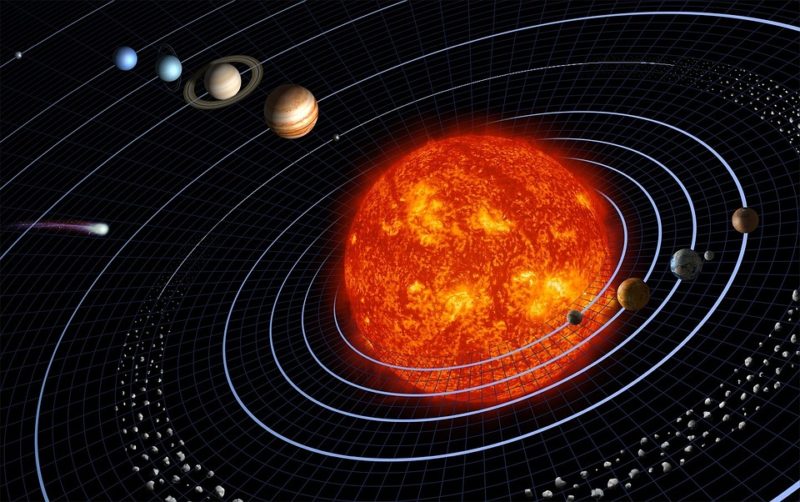The planet Mercury is almost unexplored until now. Getting there is a difficult task, and any spacecraft approaching it will have to withstand the monstrous temperature due to the proximity of the Sun. But perhaps, human settlements will be built on Mercury someday… Who can say for sure now?
Amazing facts about Mercury
- There is water ice on Mercury. It is found in craters near its poles, where sunlight never reaches.
- Mercury is the smallest planet in the Solar System. Even some gas giant moons are larger than it, such as Titan and Ganymede.
- The temperature difference on the surface of Mercury reaches 600 K depending on the time of day. This is more than on any other planet in the Solar System.
- It has an atmosphere, but it is incredibly thin. It consists of 42% oxygen.
- Despite its proximity to the Sun, Mercury isn’t the hottest planet in our system. The first place in this category belongs to Venus, which is even hotter due to the dense atmosphere and the powerful greenhouse effect.
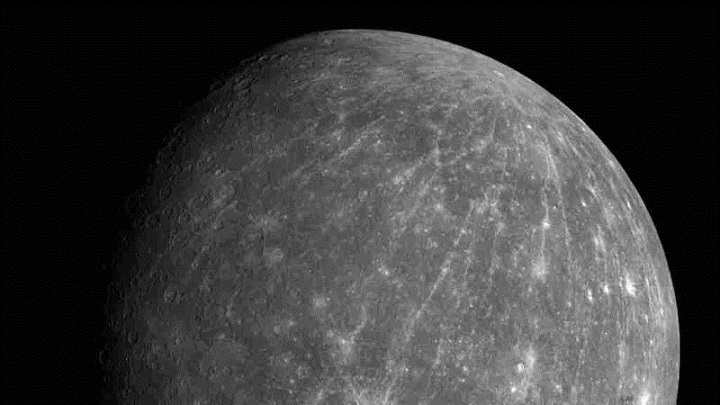
- A spacecraft needs to expend even more energy to get to Mercury than it takes to fly to the gas giants.
- It becomes the closest planet to Earth, even closer than Venus and Mars, but from time to time only, and not for long.
- Mercury was named after the eponymous God from the ancient Roman Pantheon, a fleet-footed youth. The ancient Greeks called him Hermes.
- Mercurian gravity is about three times lower than Earth’s, which is still two times more powerful than the Moon’s one.
- Amateur astronomers can observe the transit of this planet across the solar disk from time to time. In the XXI century, there were and will be 14 such transits.
- The volume of Mercury is 17.85 times less than the volume of Earth.
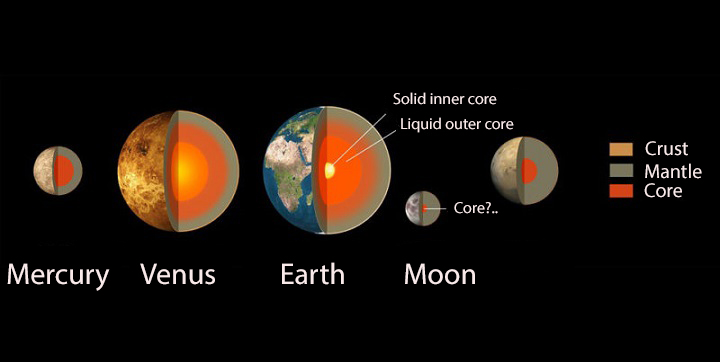
- Its core is larger in relation to the volume of the planet (about 83%) than that of any other celestial body in the Solar System. In terms of density, it ranks second among all the planets, slightly behind Earth only.
- Mercury’s magnetic field is about 100 times weaker than Earth’s, but still 5 times more powerful than the magnetic field of Mars.
- It has a comet-like tail extending 1.5 million miles (2.5 million km). But it is impossible to see it with the naked eye.
- Previously, there was a theory that mercury was once a moon of Venus but then changed its orbit due to some cataclysm. This theory is considered untenable nowadays.
- There were powerful volcanic eruptions here that formed huge lava fields billions of years ago. However, there isn’t even a single active volcano on this planet anymore.
- The core of mercury consists mainly of iron, like the Earth’s one, and it accounts for about 60% of the total planetary mass.
- The iron content in the Mercurian core is higher than in the core of any other planet in the Solar System.
- The surface of the first planet from the Sun is very similar to the surface of the Moon — the same plains and mountains dotted with impact craters.
- The highest point of Mercury’s surface lies at an altitude of 13,000 feet (4.48 km) above the local “sea level”, which is taken simply as the average level of surface height.
- The largest crater here measures approximately 947 by 817 miles (1525 by 1315 km), it is called Caloris Planitia. This is the largest object on the Mercurian surface.
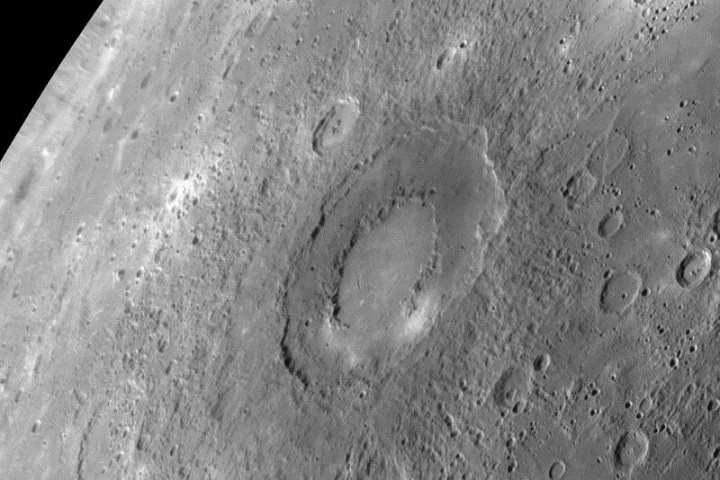
- For an observer standing on the surface of Mercury, the Sun will look 3 times larger than it looks on Earth.
- There are clouds at its poles sometimes. This phenomenon has not yet been studied.
- Mercury’s orbit is elongated more than that of any other planet in the Solar System.
- There was a theory about the presence of another planet, Vulcan, between Mercury and the Sun. Research has shown that it isn’t there after all.
- You can see Mercury from the surface of the Earth with the naked eye.
- The first documented mention of Mercury is about 5,000 years old.
- There is no change of seasons, despite the fact that at the point closest to the star (perihelion), Mercury is 1.5 times closer to the Sun than at the farthest point (aphelion).
- The diameter of its core, according to scientists, is approximately equal to the diameter of the Moon.
- Most of the Mercurian mountains are named with words that mean “mountain” in various languages.
- The colonization of Mercury is being considered for the future, and it is believed that the same methods will be suitable for it as for the colonization of the Moon. The advantage of having a settlement on this planet is obvious – unlimited energy derived from sunlight. Colonies can be located at the poles, in craters where there is no direct sunlight, but there are deposits of water ice.
- The first artificial satellite of this planet was the Messenger research probe, which arrived at the Mercurian orbit in 2011. In 2014, Messenger ran out of fuel, and in 2015, it crashed into Mercury due to the inability to correct the orbit. The probe took and transmitted more than 277,000 photos to Earth during its operation.
- There are craters on the Mercurian surface named after people who have made significant contributions to various Humanities, from poetry and music to philosophy and painting.
- The soil temperature here is stable at a depth of 3 feet (1 meter), despite its monstrous differences on the surface. The temperature is about 167 °F (75 °C).
- Mercury was considered two different planets in various ancient cultures, one of which was observed in the morning and the other in the evening, so it was given two names instead of one.
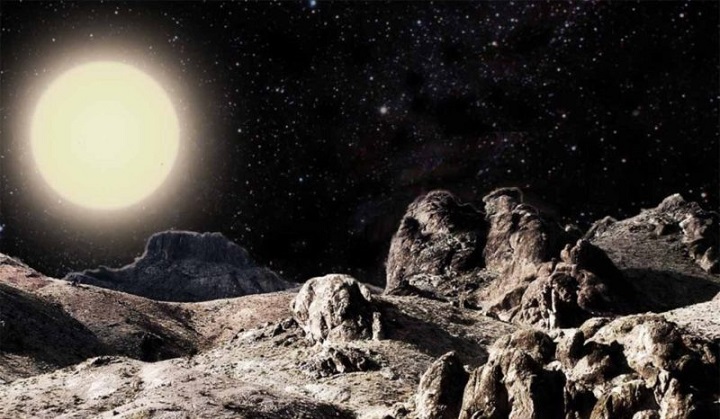
- Only one Mercurian day passes in two Mercurian years.
- That’s impossible to conduct research on Mercury using orbiting telescopes because of its proximity to the Sun.
- Mercury remains the least studied of all the inner planets. Although the least studied planet of the Solar System is Neptune.
- The first landing of an unmanned probe on Mercury is planned for the 30s of the XXI century. It should be implemented within the framework of the Russian project “Mercury-P”.
- It’s unknown who discovered this planet and when it happened. People have known about Mercury since ancient times.
- Day and night there last for one local year, which is equal to 176 standard days.
- Mercury is believed to have significant reserves of helium-3, already found on the Moon. This element will become the main source of energy for humanity in the future.
- The perihelion of this planet’s orbit is constantly shifting. Newtonian mechanics is not able to explain this, and there are probably effects of General relativity. Mercury is located very close to the Sun, and the effect of such monstrous gravity on the distortion of physical laws hasn’t been studied yet.
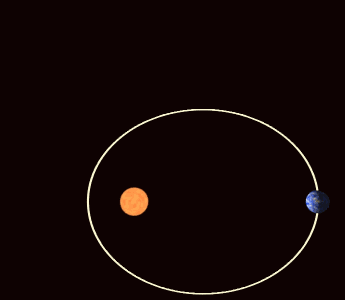
- The thickness of the water ice layer on the dark areas of the surface of Mercury reaches 6 feet (2 meters).
- Mercury seems to make loops in the sky to an observer on the surface of the Earth. For an observer on the Mercurian surface, the Sun behaves similarly. This is a consequence of the combination of the axial and orbital motion of this planet.
- The first map of the Mercurian surface was made in 2009.
- According to one theory, mercury was about 2.25 times more massive in the past, but a collision with another celestial body tore off its planetary crust.
- This planet was once subjected to a long and intense bombardment by comets and asteroids. The bombardment lasted about 1.8 billion years.
- The core of Mercury isn’t solid like the core of Mars. Scientists believe it’s liquid like Earth’s one.
- The lowest point on the surface of this planet lies 16,400 feet (5,38 km) below the average level. It’s called the Rachmaninoff crater, in honor of the great Russian & American composer.
